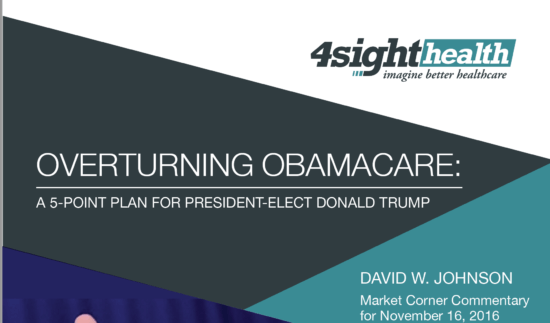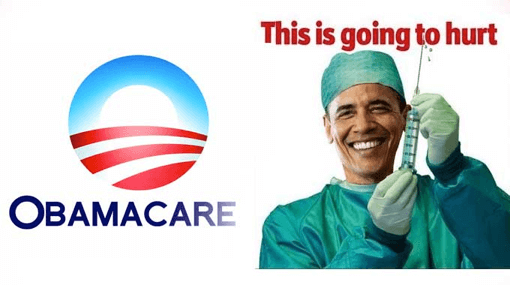November 15, 2016

Overturning Obamacare: A 5-Point Plan for President-Elect Donald Trump
Two weeks ago, I distributed a 5-Point healthcare plan for presumed President-elect Hillary Clinton. That was then. In a remarkable and unprecedented election surprise, Donald Trump defeated Hillary Clinton and will become the 45th President of the United States.
Many Americans have lost faith in the U.S. government’s ability to solve their problems. Trump campaigned on his own terms as a populist with limited support from the Republican Party. He won with a change message that connected with disaffected American voters.
Despite losses in both chambers, Republicans will retain small majorities in the Senate and House of Representatives. For the first time since 2009, the U.S. will have a unified government with all three branches of government under one party’s control.
Trump will enter the presidency with significant operating autonomy and the ability to set the government’s policy agenda. High on his agenda will be the repeal of the faltering and controversial Affordable Care Act (ACA), commonly termed Obamacare.
With great power comes great responsibility. President-elect Trump has declared his intention to be President for all Americans. He particularly wants to help working-class Americans. To achieve this vision, Trump must establish “common ground” with Congressional Democrats and Republicans. Reforming U.S. healthcare is a great place to start.

The Healthcare Opportunity
Conservative Republicans will push Trump to go “hard right” on healthcare reform. They want full Obamacare repeal and reduced coverage subsidies. Going hard right would be both a political and policy mistake for Trump.
Despite Obamacare’s divisiveness, reforming healthcare provides a unique opportunity for Republicans and Democrats to work together on major policy change. Differences are more emotional than substantive.
Obamacare’s core provisions (public exchanges, the individual mandate and insurance “risk corridors”) originated in Republican “think tanks.” It’s the best Republican bill ever passed by a Democratic Congress. Consequently, both parties party have a long-term stake in market-driven healthcare reform.
To succeed, President-elect Trump must drain the emotion from the healthcare policy debate. Accordingly, Trump should go “hard center” and engage Democrats in an honest attempt to fix America’s very broken healthcare system.
Trump has begun to do this. After meeting President Obama last Friday, he declared his support for retaining two key Obamacare provisions (no exclusions for pre-existing conditions
and family insurance coverage for adult children up to age 26).
All Americans wants better, cheaper, more convenient and compassionate healthcare. Presidents can inject new thinking and surprise into calcified political dynamics and reshape policy agendas. Anti-communist Richard Nixon went to China. Southern segregationist Lyndon Johnson led civil rights reform.
Populist Donald Trump could lead bi-partisan healthcare reform that unleashes American innovation on the nation’s most dysfunctional industry. With appropriate guidance, the U.S. can revolutionize its healthcare system by implementing reforms that promote better outcomes, embrace consumerism and deliver value. Here’s a 5-point program that advances this vision.

#1: Repeal, Rename and Repair Obamacare
Senator Patrick Moynihan observed that major legislative changes require the support of at least 70% of the American people. Not heeding Moynihan’s advice, Democrats maneuvered to pass the ACA with no Republican votes and negative public opinion.
Despite its market-based characteristics, spurned Republicans railed against Obamacare. This inflamed their base and led, in part, to the 2010 Republican takeover of Congress.
The rancor has persisted. Despite a long Congressional history of tweaking major legislation to improve its performance, partisan acrimony has prevented even simple repairs to the ACA. As a consequence, Obamacare has floundered.
Repealing Obamacare is a primary objective for Trump’s first 100 days in office. Repeal will happen, but that’s not the end of the story. Over 20 million Americans receive health insurance through Obamacare. Dis-enfranchising enrollees carries enormous political risk.
Politics is the art of the possible. Trump and fellow Republicans should not abandon Obamacare’s Republican-inspired components (e.g. public health exchanges). Instead, they should improve Obamacare’s program design and call it something else (e.g. AmericaCare).
All markets are not created equal. High-performing marketplaces have ample choice, price transparency, easy access and minimal friction. With inspired re-engineering, constant monitoring and periodic adjustment, healthcare marketplaces can offer holistic health insurance products that consumers want at reasonable prices.

2: Build a Bi-Partisan Coalition: Draft Tom Daschle
Tom Daschle is the ideal Democrat to engage as a partner in healthcare reform. The former Senate Majority leader has the gravitas, knowledge and skill to build bi-partisan support for market-based health reform
Daschle knows healthcare. In 2008 he co-wrote Critical: What We Can Do About the Healthcare Crisis, a penetrating assessment of the U.S. healthcare system with concrete suggestions for improving it.
President Obama picked Daschle to be his HHS (Health and Human Services) Secretary. Unfortunately, Daschle’s potential appointment became mired in a tax-payment controversy and he withdrew his nomination. The loss of Daschle damaged the pace, quality and acceptance of the Obama administration’s healthcare reform efforts.
Daschle believes in bi-partisan change. In 2007, Daschle co-founded the Bipartisan Policy Center with former senators Howard Baker, Bob Dole and George Mitchell. He currently co-chairs the BPC’s Commission on Political Reform and Health Project.
Trump could appeal to Daschle’s patriotism and offer him a cabinet-level “Czar” position for healthcare reform. Daschle and the new HHS Secretary could work together to design market-based reforms that could win widespread Congressional approval.
Republicans must avoid Obama’s mistake of forcing reform legislation on an objecting minority. Sole ownership of any reform legislation increases its vulnerability to repeal when political power shifts. Just ask President Obama.
With Daschle on the team, the new Trump administration would demonstrate its commitment to bipartisan reform, expand its operating maneuverability and increase the probability of enacting lasting healthcare reform.
Many will suggest that joining a Trump administration would be political suicide for Daschle. It certainly carries high risk for both sides. Daschle lost the opportunity in 2009 to lead healthcare reform for the incoming Obama administration. Joining the Trump team would enable him to tackle this important work, for which he is exceptionally well-prepared.
Democracy functions best with strong, loyal opposition parties. President-elect Trump can extend a constructive hand through Tom Daschle to House Minority Leader Nancy Pelosi, new Senate Minority Leader Chuck Schumer and their fellow Democrats. Durable healthcare reform will require their support.

#3: Modernize Medicare and Medicaid
President-elect Trump’s website lays out the following vison for its healthcare policies:
The Administration’s goal will be to create a patient-centered healthcare system that promotes choice, quality and affordability with health insurance and healthcare, and take any needed action to alleviate the burdens imposed on American families and businesses by the law.
This vision expresses “motherhood and apple pie” sentiments, but it also establishes a framework for overhauling healthcare delivery in ways that promote value-based competition, transparency and consumerism. In this spirit, the President-elect identifies Medicare modernization and more flexibility for state-managed Medicaid programs among his 6 healthcare priorities.
Medicare’s enabling legislation incorporates two original sins. The first is activity-based payment. Despite all the discussion regarding value-based reform, fee-for-service payment and the perverse economic behaviors it spawns still dominate.
The second original sin is no governmental interference in medical decision-making. As long as doctors can justify medical treatments (a very wide standard), Medicare, Medicaid and by extension commercial health insurers must pay for those treatments. Supply creates its own demand. Treatment activities disconnect from intrinsic demand for healthcare services.
U.S. healthcare employs complex, centrally-developed reimbursement formularies that private-market participants exploit for their own economic benefit. The result is a payment system that at best invites manipulation and at worst stimulates massive fraud.
More troubling than the system’s profligacy is the toll it takes on caregivers and patients. They navigate through byzantine treatment labyrinths that optimize revenue collection at the expense of care outcomes and customer experience. Far too often, American healthcare is cruel, unfeeling and mistake-prone.
Fifty-plus years of operating in this artificial economic environment has created major structural distortions within the U.S. healthcare delivery system. These include a massive asset bubble in acute care facilities, severe access limitations, an outdated academic medicine platform, and deplorable under-investment in public health.
The first step in getting out of any ditch is to stop digging. It will take decades to rationalize America’s oversupply of specialists and acute facilities, but repair must begin. U.S. healthcare should accelerate payment reforms that reduce counter-productive participant behavior.

#4: Modernize Healthcare Regulation
Centrally-administered programs have a penchant for excessive process management and data collection. This is how bureaucracies sustain themselves and grow. Instead, governments should establish clear outcome goals, measure performance and reward organizations that deliver superior results.
For example, governments make health-risk assessments and set payment levels for individuals within defined populations. They attribute these “lives” to participating health insurers in Medicare Advantage and other risk-based payment programs.
Governments could achieve better outcomes by pre-qualifying health insurers, setting program guidelines, sharing relevant de-identified patient information and letting individual companies bid to provide health insurance to defined populations.
The most promising reform programs shift health coverage risk to third-parties. These include Medicaid managed care programs, health insurance products sold on public exchanges, Medicare Advantage and various bundled payment/direct contracting programs.
A new Trump administration should accelerate movement away from fee-for-service payment and avoid imposing counter-productive regulatory requirements within new payment programs. In this sense, CMS must let go rather than double-down on regulatory data collection. Their program administrators should monitor and pay for better outcomes, not more detailed process measurement.
Like so much in healthcare, regulatory oversight is fraught with misguided decision-making mechanics. The FTC regulates hospitals while state commissions regulate health insurance companies. No oversight body sees the entire eco-system. The need for holistic perspective is essential as payer and provider business models merge.
There also is clear market failure in the pharmaceutical industry. Mylan’s stratospheric pricing for EpiPens is a recent example. Too often pharma companies set product prices on branded drugs absent real competition. It is in the long-term interests of the pharmaceutical industry, payers, providers and consumers to establish regulatory policies that balance funding innovation with fair and transparent drug prices.
The challenge is getting the right balance between market forces and regulatory oversight. Like in Goldilocks, the “regulatory porridge” can be “neither too hot nor too cold.” For generations, “level” marketplace competition has spurred innovation, turbo-charged productivity improvement and generated enormous national wealth.
Enlighted and modernized healthcare pricing and regulatory policies would facilitate superior resource allocation. “Smart” venture and private equity funding are flowing into healthcare at unprecedented levels. New companies and innovative business models see great opportunity in healthcare’s fragmented and inefficient practices.
The American economy, its people and their communities will benefit as the system delivers more appropriate and compassionate healthcare services at transparent prices.

#5: Go Retail on Individual and Community Wellness
Here’s an unfortunate truth. America could fix its broken healthcare system (right care, right time, right place, right price) and still suffer rising healthcare costs and lower worker productivity if it does not reverse escalating levels of chronic disease.
Human beings evolved to walk long distances, eat mostly vegetables, live in small cooperative communities and respond quickly to danger. We aren’t built for modern life. Sedentary work and entertainment, abundant processed foods and prolonged stress overwhelm the body’s natural defenses and trigger massive levels of debilitating chronic disease.
Society needs to make it easier for individuals to make smarter lifestyle choices. In this sense, the Trump administration should recruit ambassadors to go door-to-door promoting healthier lifestyles and healthier communities.
This is a low-cost initiative that could unite Americans across the political divide. Build a grassroots movement. Empower health coaches, teachers, caregivers and employers. The country is ready. America wants and needs true health and wellness champions.

Conclusion: Employ Raging Pragmatism to Fix American Healthcare
Donald Trump has mastered “the art of the deal.” Bold vision and big accomplishments are his hallmarks. After a highly partisan and demoralizing election, America is desperate for new energy, vision and hope. Given its dysfunction and politicization, healthcare would seem like the last place a new President could unify Americans to support major societal change.
Still, healthcare touches all individuals and every community. Who doesn’t want better, more affordable, convenient and compassionate healthcare services? It’s the right place to start.
America does not need to spend 18% of its economy to provide superior healthcare to everyone in the country. Receiving better healthcare for less money will free up enormous resources to fund other pressing needs and invest in more productive industries.
Perverse payment incentives have created a fragmented, cruel and bloated system that harms far too many Americans. Despite massive investment in healthcare, Americans are sicker than ever. More of the same will drain national resources, stifle innovation, accelerate income inequality, and curtail national productivity.
Fragmented is another word for stupid. By over-delivering acute and specialty care services, American healthcare under-delivers on preventative care, health promotion, chronic disease management and behavioral health. Individuals and communities suffer. America’s global competitiveness declines.
Sacred cows make the best hamburger. It’s time for a centrist uprising to deliver healthcare America’s citizens deserve. Here’s the revolution’s mantra: Outcomes Matter. Customers Count. Value rules! President-elect Donald Trump is ideally positioned to lead the crusade.





